12.3E: Exercises for Section 12.3
- Page ID
- 10132
Motion in Space
1) Given \(\vecs r(t)=(3t^2−2)\,\hat{\mathbf{i}}+(2t−\sin t)\,\hat{\mathbf{j}}\),
a. find the velocity of a particle moving along this curve.
b. find the acceleration of a particle moving along this curve.
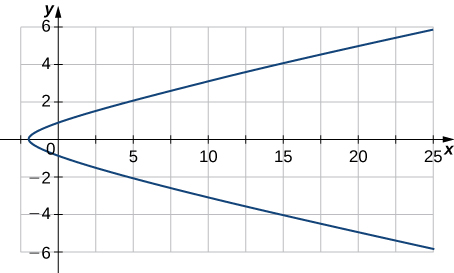
- Answer:
- a. \(\vecs v(t)=6t\,\hat{\mathbf{i}}+(2−\cos t)\,\hat{\mathbf{i}}\)
b. \(\vecs a(t)=6\,\hat{\mathbf{i}}+\sin t\,\hat{\mathbf{i}}\)
In questions 2 - 5, given the position function, find the velocity, acceleration, and speed in terms of the parameter \(t\).
2) \(\vecs r(t)=e^{−t}\,\hat{\mathbf{i}}+t^2\,\hat{\mathbf{j}}+\tan t\,\hat{\mathbf{k}}\)
3) \(\vecs r(t)=⟨3\cos t,\,3\sin t,\,t^2⟩\)
- Answer:
- \(\vecs v(t)=-3\sin t\,\hat{\mathbf{i}}+3\cos t\,\hat{\mathbf{j}}+2t\,\hat{\mathbf{k}}\)
\(\vecs a(t)=-3\cos t\,\hat{\mathbf{i}}-3\sin t\,\hat{\mathbf{j}}+2\,\hat{\mathbf{k}}\)
\(\text{Speed}(t) = \|\vecs v(t)\| = \sqrt{9 + 4t^2}\)
4) \(\vecs r(t)=t^5\,\hat{\mathbf{i}}+(3t^2+2t- 5)\,\hat{\mathbf{j}}+(3t-1)\,\hat{\mathbf{k}}\)
5) \(\vecs r(t)=2\cos t\,\hat{\mathbf{j}}+3\sin t\,\hat{\mathbf{k}}\). The graph is shown here:
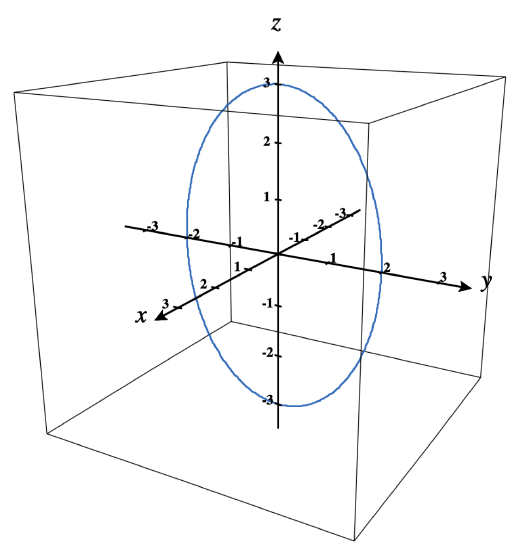
- Answer:
- \(\vecs v(t)=-2\sin t\,\hat{\mathbf{j}}+3\cos t\,\hat{\mathbf{k}}\)
\(\vecs a(t)=-2\cos t\,\hat{\mathbf{j}}-3\sin t\,\hat{\mathbf{k}}\)
\(\text{Speed}(t) = \|\vecs v(t)\| = \sqrt{4\sin^2 t+9\cos^2 t}=\sqrt{4+5\cos^2 t}\)
In questions 6 - 8, find the velocity, acceleration, and speed of a particle with the given position function.
6) \(\vecs r(t)=⟨t^2−1,t⟩\)
7) \(\vecs r(t)=⟨e^t,e^{−t}⟩\)
- Answer:
- \(\vecs v(t)=⟨e^t,−e^{−t}⟩\),
\(\vecs a(t)=⟨e^t, e^{−t}⟩,\)
\( \|\vecs v(t)\| = \sqrt{e^{2t}+e^{−2t}}\)
8) \(\vecs r(t)=⟨\sin t,t,\cos t⟩\). The graph is shown here:
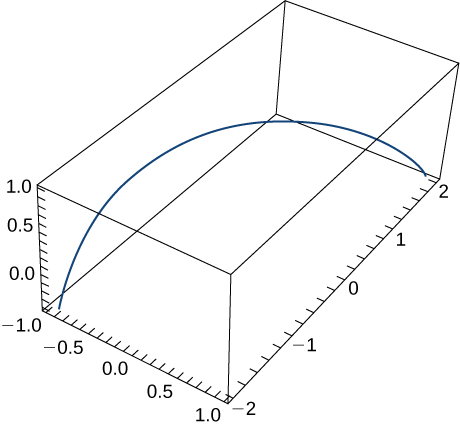
9) The position function of an object is given by \(\vecs r(t)=⟨t^2,5t,t^2−16t⟩\). At what time is the speed a minimum?
- Answer:
- \(t = 4\)
10) Let \(\vecs r(t)=r\cosh(ωt)\,\hat{\mathbf{i}}+r\sinh(ωt)\,\hat{\mathbf{j}}\). Find the velocity and acceleration vectors and show that the acceleration is proportional to \(\vecs r(t)\).
11) Consider the motion of a point on the circumference of a rolling circle. As the circle rolls, it generates the cycloid \(\vecs r(t)=(ωt−\sin(ωt))\,\hat{\mathbf{i}}+(1−\cos(ωt))\,\hat{\mathbf{j}}\), where \(\omega\) is the angular velocity of the circle and \(b\) is the radius of the circle:
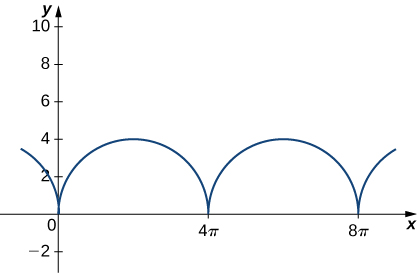
Find the equations for the velocity, acceleration, and speed of the particle at any time.
- Answer:
- \(\vecs v(t)=(ω−ω\cos(ωt))\,\hat{\mathbf{i}}+(ω\sin(ωt))\,\hat{\mathbf{j}}\)
\(\vecs a(t)=(ω^2\sin(ωt))\,\hat{\mathbf{i}}+(ω^2\cos(ωt))\,\hat{\mathbf{j}}\)
\(\begin{align*} \text{speed}(t) &= \sqrt{(ω−ω\cos(ωt))^2 + (ω\sin(ωt))^2} \\
&= \sqrt{ω^2 - 2ω^2 \cos(ωt) + ω^2\cos^2(ωt) + ω^2\sin^2(ωt)} \\
&= \sqrt{2ω^2(1 - \cos(ωt))} \end{align*} \)
12) A person on a hang glider is spiraling upward as a result of the rapidly rising air on a path having position vector \(\vecs r(t)=(3\cos t)\,\hat{\mathbf{i}}+(3\sin t)\,\hat{\mathbf{j}}+t^2\,\hat{\mathbf{k}}\). The path is similar to that of a helix, although it is not a helix. The graph is shown here:
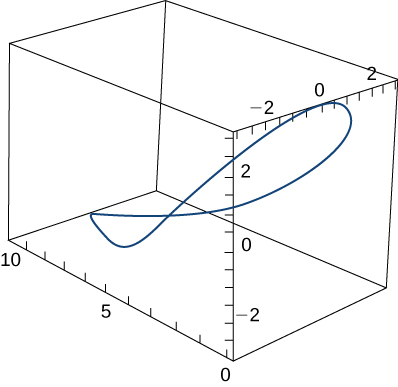
Find the following quantities:
a. The velocity and acceleration vectors
b. The glider’s speed at any time
- Answer:
- \(\|\vecs v(t)\|=\sqrt{9+4t^2}\)
c. The times, if any, at which the glider’s acceleration is orthogonal to its velocity
13) Given that \(\vecs r(t)=⟨e^{−5t}\sin t,\, e^{−5t}\cos t,\, 4e^{−5t}⟩\) is the position vector of a moving particle, find the following quantities:
a. The velocity of the particle
- Answer:
- \(\vecs v(t)=⟨e^{−5t}(\cos t−5\sin t),\, −e^{−5t}(\sin t+5\cos t),\, −20e^{−5t}⟩\)
b. The speed of the particle
c. The acceleration of the particle
- Answer:
- \(\vecs a(t)=⟨e^{−5t}(−\sin t−5\cos t)−5e^{−5t}(\cos t−5\sin t), \; −e^{−5t}(\cos t−5\sin t)+5e^{−5t}(\sin t+5\cos t),\; 100e^{−5t}⟩\)
14) Find the maximum speed of a point on the circumference of an automobile tire of radius \(1\) ft when the automobile is traveling at \(55\) mph.
15) Find the position vector-valued function \(\vecs r(t)\), given that \(\vecs a(t)=\hat{\mathbf{i}}+e^t \,\hat{\mathbf{j}}, \quad \vecs v(0)=2\,\hat{\mathbf{j}}\), and \(\vecs r(0)=2\,\hat{\mathbf{i}}\).
16) Find \(\vecs r(t)\) given that \(\vecs a(t)=−32\,\hat{\mathbf{j}}, \vecs v(0)=600\sqrt{3} \,\hat{\mathbf{i}}+600\,\hat{\mathbf{j}}\), and \(\vecs r(0)=\vecs 0\).
17) The acceleration of an object is given by \(\vecs a(t)=t\,\hat{\mathbf{j}}+t\,\hat{\mathbf{k}}\). The velocity at \(t=1\) sec is \(\vecs v(1)=5\,\hat{\mathbf{j}}\) and the position of the object at \(t=1\) sec is \(\vecs r(1)=0\,\hat{\mathbf{i}}+0\,\hat{\mathbf{j}}+0\,\hat{\mathbf{k}}\). Find the object’s position at any time.
- Answer:
- \(\vecs r(t)=0\,\hat{\mathbf{i}}+\left(\frac{1}{6}t^3+4.5t−\frac{14}{3}\right)\,\hat{\mathbf{j}}+\left(\frac{1}{6}t^3−\frac{1}{2}t+\frac{1}{3}\right)\,\hat{\mathbf{k}}\)
Projectile Motion
18) A projectile is shot in the air from ground level with an initial velocity of \(500\) m/sec at an angle of 60° with the horizontal.
a. At what time does the projectile reach maximum height?
- Answer:
- \(44.185\) sec
b. What is the approximate maximum height of the projectile?
c. At what time is the maximum range of the projectile attained?
- Answer:
- \(t=88.37\) sec
d. What is the maximum range?
e. What is the total flight time of the projectile?
- Answer:
- \(t=88.37\) sec
19) A projectile is fired at a height of \(1.5\) m above the ground with an initial velocity of \(100\) m/sec and at an angle of 30° above the horizontal. Use this information to answer the following questions:
a. Determine the maximum height of the projectile.
b. Determine the range of the projectile.
- Answer:
- The range is approximately \(886.29\) m.
20) A golf ball is hit in a horizontal direction off the top edge of a building that is 100 ft tall. How fast must the ball be launched to land \(450\) ft away?
21) A projectile is fired from ground level at an angle of 8° with the horizontal. The projectile is to have a range of \(50\) m. Find the minimum velocity (speed) necessary to achieve this range.
- Answer:
- \(v=42.16\) m/sec
22) Prove that an object moving in a straight line at a constant speed has an acceleration of zero.
Contributors
Gilbert Strang (MIT) and Edwin “Jed” Herman (Harvey Mudd) with many contributing authors. This content by OpenStax is licensed with a CC-BY-SA-NC 4.0 license. Download for free at http://cnx.org.


